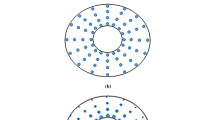Abstract
The goal of this paper is to apply the recently developed theory of buckling of arbitrary slender bodies to a tractable yet non-trivial example of buckling in axially compressed circular cylindrical shells, regarded as three-dimensional hyperelastic bodies. The theory is based on a mathematically rigorous asymptotic analysis of the second variation of 3D, fully nonlinear elastic energy, as the shell’s thickness goes to zero. Our main results are a rigorous proof of the classical formula for buckling load and the explicit expressions for the relative amplitudes of displacement components in single Fourier harmonics buckling modes, whose wave numbers are described by Koiter’s circle. This work is also a part of an effort to understand the root causes of high sensitivity of the buckling load of axially compressed cylindrical shells to imperfections of load and shape.

Similar content being viewed by others
Notes
The assumption that the reference configuration is stress-free is also essential.
While hyperelasticity is hardly the “ultimate” theory of elasticity, it is sufficiently general to permit rigorous study of the asymptotics of the buckling load of a slender structure.
A deformation y is called a weak local minimizer, if it delivers the smallest value of the energy \(\mathcal {E}(\boldsymbol{y})\) among all Lipschitz function satisfying boundary conditions (2.1) that are sufficiently close to y in the W 1,∞ norm.
We restrict our attention to Lipschitz equilibria for technical simplicity of the theory. On the one hand, in most cases of interest, and for a cylindrical shells in particular, the strains and stresses in the trivial branch are uniformly bounded. On the other, the presence or absence of higher spatial derivatives of strains and stresses are immaterial for the theory, and hence no assumptions about them are made.
The set \({\mathcal{A}}_{h}\) could be empty, in which case there are no destabilizing variations, so that the trivial branch remains stable in a neighborhood of (0,0) in the (h,λ)-plane.
Here we consider cylindrical shells of radius 1 and lengths that are uniformly bounded away from 0 and infinity. We therefore do not examine explicit dependence of our constants on L, since it does not affect our results. The cases L→∞ or L→0 are beyond the scope of this paper.
This lemma highlights the fact that Part (b) in Definition 2.10 is designed to capture a buckling mode. We make no attempt to characterize an infinite set of geometrically distinct, yet energetically equivalent buckling modes that exist in our example.
Meaning that each component of e(ϕ) and its trace either changes sign or remains unchanged.
References
Almroth, B.O.: Postbuckling behaviour of axially compressed circular cylinders. AIAA J. 1, 627–633 (1963)
Budiansky, B., Hutchinson, J.: A survey of some buckling problems. Technical Report CR-66071, NASA (February 1966)
Fonseca, I., Fusco, N., Leoni, G., Morini, M.: Equilibrium configurations of epitaxially strained crystalline films: existence and regularity results. Arch. Ration. Mech. Anal. 186(3), 477–537 (2007)
Friesecke, G., James, R.D., Mora, M.G., Müller, S.: Derivation of nonlinear bending theory for shells from three-dimensional nonlinear elasticity by gamma-convergence. C. R. Math. 336(8), 697–702 (2003)
Grabovsky, Y., Harutyunyan, D.: Scaling instability of the buckling load in axially compressed cylindrical shells (submitted)
Grabovsky, Y., Harutyunyan, D.: Exact scaling exponents in Korn and Korn-type inequalities for cylindrical shells. SIAM J. Math. Anal. 46(5), 3277–3295 (2014)
Grabovsky, Y., Truskinovsky, L.: The flip side of buckling. Contin. Mech. Thermodyn. 19(3–4), 211–243 (2007)
Holden, J.T.: Estimation of critical loads in elastic stability theory. Arch. Ration. Mech. Anal. 17, 171–183 (1964)
Horák, J., Lord, G.J., Peletier, M.A.: Cylinder buckling: the mountain pass as an organizing center. SIAM J. Appl. Math. 66(5), 1793–1824 (2006) (electronic)
Horgan, C.O.: Korn’s inequalities and their applications in continuum mechanics. SIAM Rev. 37(4), 491–511 (1995)
Koiter, W.T.: On the stability of elastic equilibrium. Ph.D. Thesis, Technische Hogeschool (Technological University of Delft), Delft, Holland (1945)
Lancaster, E., Calladine, C., Palmer, S.: Paradoxical buckling behaviour of a thin cylindrical shell under axial compression. Int. J. Mech. Sci. 42(5), 843–865 (2000)
Lorenz, R.: Die nicht achsensymmetrische Knickung dünnwandiger Hohlzylinder. Phys. Z. 12(7), 241–260 (1911)
Nazarov, S.A.: Korn inequalities for elastic junctions of massive bodies, thin plates, and rods. Russ. Math. Surv. 63(1), 35 (2008)
Tennyson, R.C.: An experimental investigation of the buckling of circular cylindrical shells in axial compression using the photoelastic technique. Tech. Report 102, University of Toronto, Toronto, ON, Canada (1964)
Timoshenko, S.: Towards the question of deformation and stability of cylindrical shell. Vesti Obshestva Tekhnologii 21, 785–792 (1914)
Triantafyllidis, N., Kwon, Y.J.: Thickness effects on the stability of thin walled structures. J. Mech. Phys. Solids 35, 643–674 (1987)
Weingarten, V.I., Morgan, E.J., Seide, P.: Elastic stability of thin-walled cylindrical and conical shells under axial compression. AIAA J. 3, 500–505 (1965)
Zhu, E., Mandal, P., Calladine, C.: Buckling of thin cylindrical shells: an attempt to resolve a paradox. Int. J. Mech. Sci. 44(8), 1583–1601 (2002)
Acknowledgements
The authors are grateful to Eric Clement and Mark Peletier for their valuable comments and suggestions. This material is based upon work supported by the National Science Foundation under Grant No. 1412058.
Author information
Authors and Affiliations
Corresponding author
Rights and permissions
About this article
Cite this article
Grabovsky, Y., Harutyunyan, D. Rigorous Derivation of the Formula for the Buckling Load in Axially Compressed Circular Cylindrical Shells. J Elast 120, 249–276 (2015). https://doi.org/10.1007/s10659-015-9513-x
Received:
Published:
Issue Date:
DOI: https://doi.org/10.1007/s10659-015-9513-x




